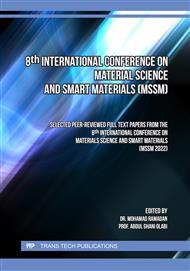[1]
K. Osmani et al., "Recent progress in the thermal management of lithium-ion batteries," J Clean Prod, vol. 389, p.136024, 2023.
DOI: 10.1016/j.jclepro.2023.136024
Google Scholar
[2]
M. N. Khan et al., "Air cooled lithium-ion battery with cylindrical cell in phase change material filled cavity of different shapes," J Energy Storage, vol. 50, p.104573, 2022.
DOI: 10.1016/j.est.2022.104573
Google Scholar
[3]
P. Qin, J. Sun, X. Yang, and Q. Wang, "Battery thermal management system based on the forced-air convection: A review," eTransportation, vol. 7. 2021.
DOI: 10.1016/j.etran.2020.100097
Google Scholar
[4]
Y. Zhang, C. Y. Wang, and X. Tang, "Cycling degradation of an automotive LiFePO4 lithium-ion battery," J Power Sources, vol. 196, no. 3, 2011.
DOI: 10.1016/j.jpowsour.2010.08.070
Google Scholar
[5]
J. R. Belt, C. D. Ho, T. J. Miller, M. A. Habib, and T. Q. Duong, "The effect of temperature on capacity and power in cycled lithium ion batteries," J Power Sources, vol. 142, no. 1–2, 2005.
DOI: 10.1016/j.jpowsour.2004.10.029
Google Scholar
[6]
W. Situ et al., "Effect of high temperature environment on the performance of LiNi0.5Co0.2Mn0.3O2 battery," Int J Heat Mass Transf, vol. 104, 2017.
DOI: 10.1016/j.ijheatmasstransfer.2016.09.005
Google Scholar
[7]
H. Shi et al., "A thermal-optimal design of lithium-ion battery for the container storage system," Energy Sci Eng, vol. 10, no. 3, 2022.
DOI: 10.1002/ese3.1076
Google Scholar
[8]
Z. Ling, M. Luo, J. Song, W. Zhang, Z. Zhang, and X. Fang, "A fast-heat battery system using the heat released from detonated supercooled phase change materials," Energy, vol. 219, 2021.
DOI: 10.1016/j.energy.2020.119496
Google Scholar
[9]
G. Zhong et al., "Researches of composite phase change material cooling/resistance wire preheating coupling system of a designed 18650-type battery module," Appl Therm Eng, vol. 127, 2017.
DOI: 10.1016/j.applthermaleng.2017.08.022
Google Scholar
[10]
A. Mitra, R. Kumar, D. K. Singh, and Z. Said, "Advances in the improvement of thermal-conductivity of phase change material-based lithium-ion battery thermal management systems: An updated review," J Energy Storage, vol. 53, p.105195, 2022.
DOI: 10.1016/j.est.2022.105195
Google Scholar
[11]
J. Xie, Y. Wang, S. He, X. Liu, and X. Yang, "A Simple Cooling Structure with Precisely-Tailored Liquid Cooling Plate for Thermal Management of Large Battery Module," SSRN Electronic Journal, 2022.
DOI: 10.2139/ssrn.3999109
Google Scholar
[12]
A. Baroutaji et al., "Advancements and prospects of thermal management and waste heat recovery of PEMFC," International Journal of Thermofluids, vol. 9, 2021.
DOI: 10.1016/j.ijft.2021.100064
Google Scholar
[13]
E. Jiaqiang et al., "Effects of the different air cooling strategies on cooling performance of a lithium-ion battery module with baffle," Appl Therm Eng, vol. 144, 2018.
DOI: 10.1016/j.applthermaleng.2018.08.064
Google Scholar
[14]
R. D. Jilte, R. Kumar, M. H. Ahmadi, and L. Chen, "Battery thermal management system employing phase change material with cell-to-cell air cooling," Applied Thermal Engineering, vol. 161. 2019.
DOI: 10.1016/j.applthermaleng.2019.114199
Google Scholar
[15]
S. Al-Hallaj and J. R. Selman, "Thermal modeling of secondary lithium batteries for electric vehicle/hybrid electric vehicle applications," J Power Sources, vol. 110, no. 1, 2002.
DOI: 10.1016/s0378-7753(02)00196-9
Google Scholar
[16]
P. Goli, S. Legedza, A. Dhar, R. Salgado, J. Renteria, and A. A. Balandin, "Graphene-enhanced hybrid phase change materials for thermal management of Li-ion batteries," J Power Sources, vol. 248, 2014.
DOI: 10.1016/j.jpowsour.2013.08.135
Google Scholar
[17]
Z. Wang, Y. Liu, and M. Z. Mahmoud, "Simultaneous application of active and passive methods in cooling of a cylindrical lithium-ion battery by changing the size of the elliptical cavity filled with nano phase change materials," J Energy Storage, vol. 50, p.104693, 2022.
DOI: 10.1016/j.est.2022.104693
Google Scholar



